I have been fascinated by the idea of chook tunnels for many years. Unfortunately I put our chook systems together before I was aware of their existence so it has not yet made sense to install our own here. Fortunately I do have friends who have made good use of them.
Surprisingly enough, I have found that chook books refer to chook tunnels only rarely but there is some information on the net and suggestions for further reading are included at the end of this article.
So, what is a chook tunnel I hear you ask!
Chook tunnels, are enclosed pathways that allow chooks to move safely and freely around a yard or garden. They provide extra space for chickens to roam, forage, and explore, helping to keep them entertained and active.
Why Bother?
Increased Space
Chook tunnels can greatly increase the available space for chooks, increasing the environments they can have access to which enhances the chooks health and productivity.
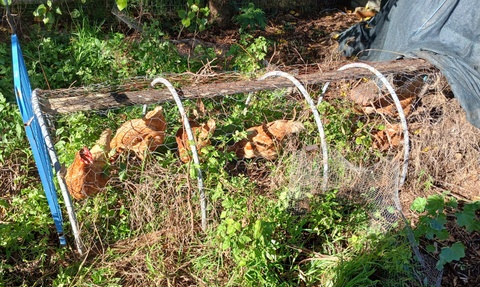
Chook tunnel excursion
Protection of the chooks
They offer a safe and secure environment while allowing the chooks a certain freedom of movement, while also protecting chickens from predators.
Protection of the Garden
If anyone who has kept chooks and they have gained unauthorised access to food growing areas, they will know just how much havoc even one chook can wreak on a veggie patch in a surprisingly short time. Chook tunnels can give chooks freedom of movement while preventing them from destroying our well-tended food growing areas.
Improved Foraging
Chook tunnels allow chooks to safely forage in different areas of the yard or garden without getting unauthorised access to sensitive areas of the garden. Jose (in example 1 below) used chook tunnels to allow chook access to the area just inside his backyard fence, using their foraging skills to demolish weeds sneaking through the fence from the neigbours’ yards.
Ease of Access
Tunnels make it easy for chooks to move from one area to another, increasing their physical activity and well-being.
Design and Construction
Chook tunnels are typically made from a wire mesh or welded wire fence that is supported by posts or other structures. The chook tunnels in the example 1 below also uses shade cloth as a cover, which is cheaper and easier to work with than wire mesh.
They can be customized to fit specific needs, designed to be moved around or adjusted to different configurations as Selina does in example 2 or fixed in design, such as using a perimeter fence as part of their structure.
The size of the holes in the mesh should be small enough to prevent predators from entering and keeping chooks from escaping. Chooks can be remarkably adept at escaping and if you leave a weak link in the construction you can bet they will find it and exploit it!
Design Considerations
Predator Protection
Ensure the mesh is strong and the holes are small enough to prevent predators from entering. This depends on the type of predators that you have to deal with, whether foxes, dogs, eagles or hawks, or feral cats, make sure the basic structure and any wire cover are up to the job. The reason I went overboard with our first chook tractor was to make it predator proof, but here in our suburbs we haven’t had problems with predators for the 40 odd years we have been keeping our chooks. Research is good!
Escape Routes
As mentioned earlier, check for any potential escape routes, especially around the base of the tunnel, and reinforce them as needed to keep those little escape artists secure.. Burying the wire mesh will keep the chooks in, the flip side being it will also help keep predators out.
Garden Access
If chickens need to access the garden, consider using specific tunnels or designs that allow them to forage without causing damage. In example 3 below, Selina uses chook tunnels to conduct her chooks between the areas where she wants them to work, without risking any existing garden areas.
Fencing Materials
It would be worth considering what materials the fence is composed of if you are going to use the fence as part of the chook tunnel. If it is wood it will probably be constructed with treated timber (CCA) and if the chooks peck at it it could cause problems with toxicity. Consider lining the fence side if this is a concern. Also, if you property is an old one with a wood fence, sump oil could have been painted on the fence to preserve the timbers, it would be worth checkin in to the history of the property if you can.
Examples
Example 1 – Jose & Lisa
Jose and Lisa have a large suburban back yard that they use to grow food using the Linda Woodrow process of moving a round chook tractor across a series of beds growing a variety of crops. They have used chook tunnels in a number of ways.
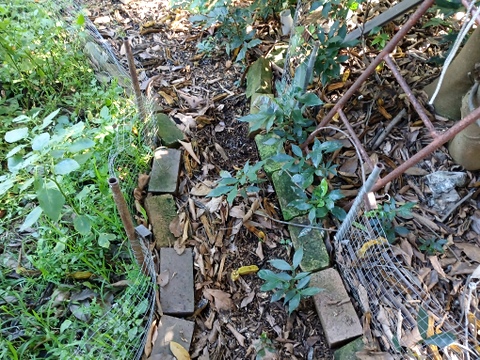
Two circles set up with a small area for a chook tunnel to allow access between them
One way they used chook tunnels was to control the chooks moving between patches, allowing them to transfer between beds without getting side tracked.
They have also connected a partial chook tunnel to a chook tractor to give the chooks extra foraging range and to direct them to where they wants them to go when outside the chook tractor. To construct a chook tunnel for this purpose he used a timber strip on each side for the base, and one in the centre to form part of the roof, then ran some PVC electrical conduit between the two timber strips and then covered the timber/conduit with chicken wire. He then moved the sides close together to form the tunnel and secured them with a piece of timber on each end.
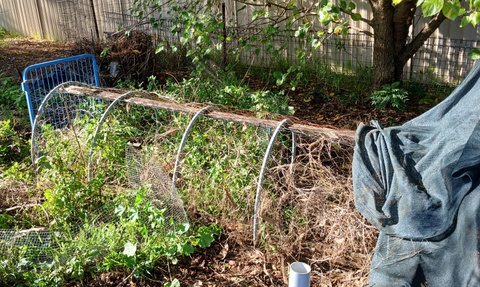
Chook tunnel made with timber, conduit and chook wire
Another way he used chook tunnels was to build them around the inside of his perimeter fence, the idea being that they would form a barrier against invasive weeds coming under the fence and colonising his yard. The method of construction for this type of tunnel was different, he used galvanised steel fencing mesh recovered from council pick ups. To make the tunnels he then secured 30cm to 45cm away from the fence using star pickets, then covered the set up with shade cloth, which was cheaper, lighter and easier to work with than the chicken wire over the longer distance.
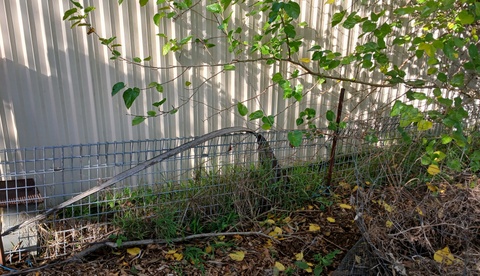
Chook tunnel around the edge of the property using wire fencing
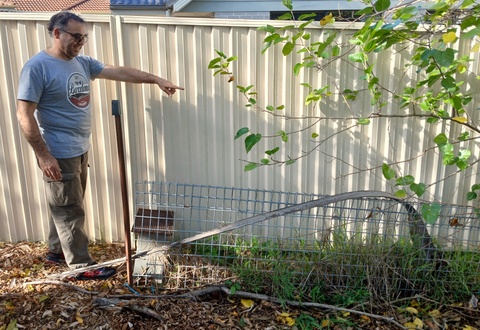
Jose, indicating the height the shade cloth would be installed to
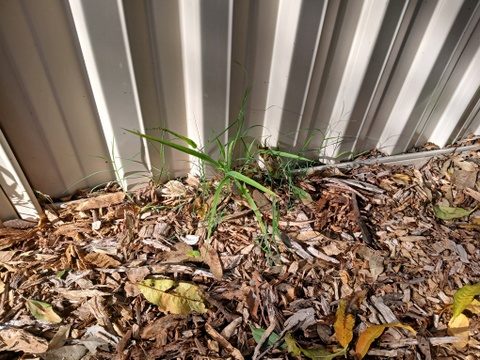
Weed invasion the chook would mitigate against
They have used the chook tunnel idea in many ways to help them manage their chooks, getting the most from them while providing a variety of environments for the chooks to experience.
Example 2 - Selina
Selina has a small suburban back yard, which is where the primary chook pen and sleeping area is located, adjacent to the southern face of the house. There is a chook tunnel that runs from this main pen around several fences until it meets up with a secondary pen and feeding area at the south end of the front yard.
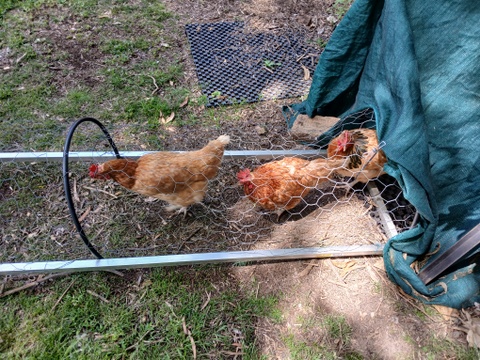
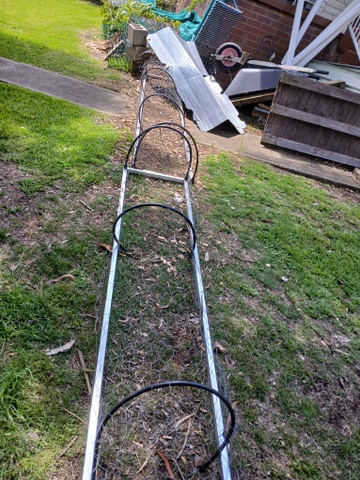
Moveable tunnels
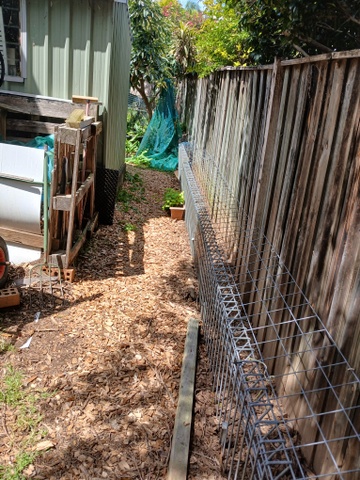
Fixed tunnels alongside the fence
There is a chook tunnel which exits from the north wall of this secondary pen, and heads north along the front of the house that directs the chooks from the pen to their current work area.
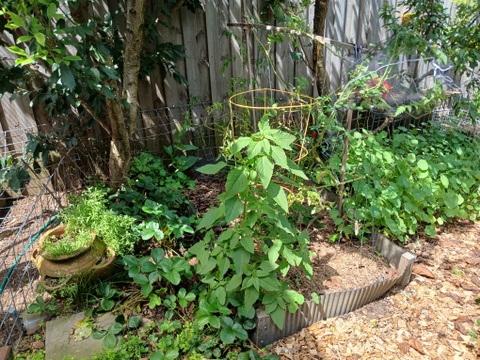
Note chook more tunnels fixed to the fence
In terms of construction, the chook tunnels in the back yard are constructed from wire fencing mesh side and top, with the fence forming the second side. Part of the chook tunnel in the front yard is constructed using square aluminium tubing as the base with plastic tubing hoops and a covering of chook wire keeping it light and easy to move around. There is also a more permanent section that is adjacent to the front of the house that is also constructed from fencing wire, the house forms one of the sides and it is covered with shade cloth.
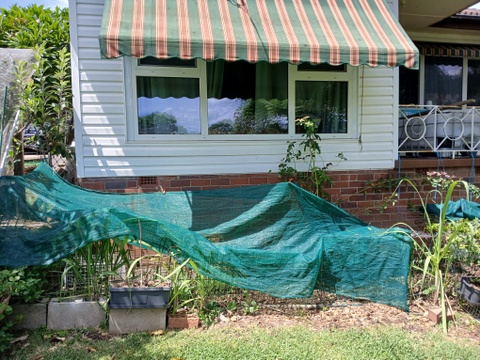
Selina uses her chook tunnels to make the most of her chooks, protecting them while allowing them access to different areas of her property.
Further Reading
The Chicken Tunnel | Good Life Permaculture
83 Best Chicken Tunnels ideas | chicken tunnels, chickens backyard, chicken diy


